Related Research Articles
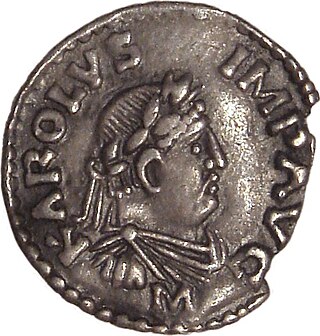
Charlemagne was King of the Franks from 768, King of the Lombards from 774, and Emperor of what is now known as the Carolingian Empire from 800, holding these titles until his death in 814. He united most of Western and Central Europe, and was the first recognised emperor to rule from the west after the fall of the Western Roman Empire approximately three centuries earlier. Charlemagne's reign was marked by political and social changes that had lasting influence on Europe throughout the Middle Ages.

Pope Boniface IX was head of the Catholic Church from 2 November 1389 to his death, in October 1404. He was the second Roman pope during the Western Schism. In this time, the Avignon claimants, Clement VII and Benedict XIII, maintained the Roman Curia in Avignon, under the protection of the French monarchy. He is the last pope to date to take on the pontifical name "Boniface".

The Avignon Papacy was the period from 1309 to 1376 during which seven successive popes resided in Avignon rather than in Rome. The situation arose from the conflict between the papacy and the French crown, culminating in the death of Pope Boniface VIII after his arrest and maltreatment by Philip IV of France. Following the subsequent death of Pope Benedict XI, Philip forced a deadlocked conclave to elect the French Clement V as pope in 1305. Clement refused to move to Rome, and in 1309 he moved his court to the papal enclave at Avignon, where it remained for the next 67 years. This absence from Rome is sometimes referred to as the "Babylonian captivity" of the Papacy.

Pope Telesphorus was the bishop of Rome from c. 126 to his death c. 137, during the reigns of Roman Emperors Hadrian and Antoninus Pius.
The Mirabilis liber is an anonymous and formerly very popular compilation of predictions by various Christian saints and diviners first printed in France in 1522 and reprinted several times thereafter. It is not to be confused with the almost contemporary Liber mirabilis. Its unwitting contributors include:
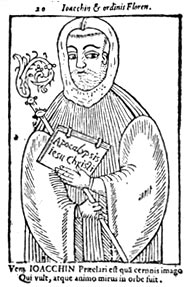
Joachim of Fiore, also known as Joachim of Flora, was an Italian Christian theologian, Catholic abbot, and the founder of the monastic order of San Giovanni in Fiore. According to theologian Bernard McGinn, "Joachim of Fiore is the most important apocalyptic thinker of the whole medieval period." The Divine Comedy of Dante Alighieri is one of the most famous works possibly inspired by his ideas. Later followers, inspired by his works in Christian eschatology and historicist theories, are called Joachimites. On June 27, 2024, Pope Francis, in his message for the World Day of Creation, described Joachim of Fiore, saying that "Joachim was able to propose the ideal of a new spirit of coexistence among people" and thus marks a turning point in history, as this had not happened in more than eight centuries since the death of the Florensis monk.
In Christian eschatology, historicism is a method of interpretation of biblical prophecies which associates symbols with historical persons, nations or events. The main primary texts of interest to Christian historicists include apocalyptic literature, such as the Book of Daniel and the Book of Revelation. It sees the prophecies of Daniel as being fulfilled throughout history, extending from the past through the present to the future. It is sometimes called the continuous historical view. Commentators have also applied historicist methods to ancient Jewish history, to the Roman Empire, to Islam, to the Papacy, to the Modern era, and to the end time.
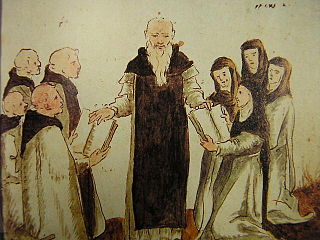
The Vaticinia Michaelis Nostradami de Futuri Christi Vicarii ad Cesarem Filium D. I. A. Interprete, or Vaticinia Nostradami for short, is a collection of eighty watercolor images compiled as an illustrated codex. A version of the well-known Vaticinia de Summis Pontificibus of the 13th–14th century, it was discovered in 1994 by the Italian journalists Enza Massa and Roberto Pinotti in the Biblioteca Nazionale Centrale di Roma in Rome, Italy. The document can be found in the library under the title Fondo Vittorio Emanuele 307.
Cyril of Constantinople was reputed to have been a Prior General of the Order of Carmelites and prior of the hermits on Mount Carmel for three years. He is said to have had the gift of prophecy.
Abraham von Franckenberg was a German mystic, author, poet and hymn-writer.

A series of manuscript prophecies concerning the Papacy, under the title of Vaticinia de Summis Pontificibus, a Latin text which assembles portraits of popes and prophecies related to them, circulated from the late thirteenth-early fourteenth century, with prophecies concerning popes from Pope Nicholas III onwards.
Last Roman Emperor, also known as Last World Emperor or Emperor of the Last Days, is a figure of medieval European legend, which developed as an aspect of Christian eschatology. The legend predicts that in the end times, a last emperor would appear on earth to reestablish the Roman Empire and assume his function as biblical katechon who stalls the coming of the Antichrist. The legend first appears in the 7th-century apocalyptic text known as the Apocalypse of Pseudo-Methodius; that and the oracles of the Tiburtine Sibyl are its two most important sources. It developed over the centuries, becoming particularly prominent in the 15th century. The notion of Great Catholic Monarch is related to it.
Petrus Boeri was a French Benedictine canonist and bishop.

The Latin poem conventionally titled Visio Karoli Magni, and in the manuscripts Visio Domini Karoli Regis Francorvm, was written by an anonymous East Frank around 865. Sometimes classified as visionary literature, the Visio is not a typical example the genre, since the "vision" it presents is merely a dream.
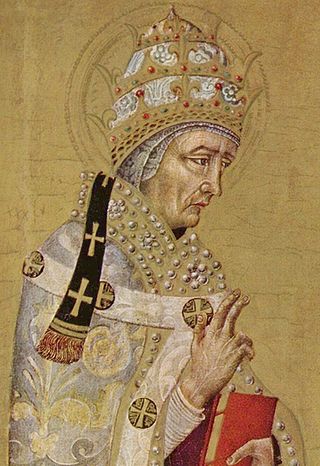
The selection of the Pope, the Bishop of Rome and Supreme Pontiff of the Catholic Church, prior to the promulgation of In Nomine Domini in AD 1059 varied throughout history. Popes were often putatively appointed by their predecessors or by political rulers. While some kind of election often characterized the procedure, an election that included meaningful participation of the laity was rare, especially as the Popes' claims to temporal power solidified into the Papal States. The practice of papal appointment during this period would later result in the putative jus exclusivae, i.e., the claimed but invalid right to veto the selection that Catholic monarchs exercised into the twentieth century.

In the 9th century, Christianity was spreading throughout Europe, being promoted especially in the Carolingian Empire, its eastern neighbours, Scandinavia, and northern Spain. In 800, Charlemagne was crowned as Holy Roman Emperor, which continued the Photian schism.
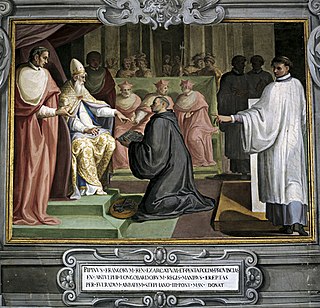
From 756 to 857, the papacy shifted from the influence of the Byzantine Empire to that of the kings of the Franks. Pepin the Short, Charlemagne, and Louis the Pious had considerable influence in the selection and administration of popes. The "Donation of Pepin" (756) ratified a new period of papal rule in central Italy, which became known as the Papal States.
Peter Damian was an Italian reforming Benedictine monk and cardinal in the circle of Pope Leo IX. Dante placed him in one of the highest circles of Paradiso as a great predecessor of Francis of Assisi and he was declared a Doctor of the Church on 27 September 1828. His feast day is 21 February.
James Maxwell was a Scottish scholar, known as an author on mythology and prophecy. Most of his works are lost. He advocated for the view that the House of Stuart would found the Last World Empire of prophetic tradition.
Alexander of Roes was the dean of St. Maria im Kapitol, Cologne, canon law jurist, and author on history and prophecy. He was a member of a patrician Cologne family and was a member of the social group in Rome headed by Cardinal Jacobus de Columna, to whom he dedicated Memoriale...
References
- ↑ Werner Verbeke; D. Verhelst; Andries Welkenhuysen (1 January 1988). The Use and Abuse of Eschatology in the Middle Ages. Leuven University Press. p. 24. ISBN 978-90-6186-259-8.
- ↑ Marjorie Reeves (1976). Joachim of Fiore and the Prophetic Future. SPCK. pp. 69–70. ISBN 0-281-02887-7.
- Attribution
 This article incorporates text from a publication now in the public domain : Herbermann, Charles, ed. (1913). "Telesphorus of Cosenza". Catholic Encyclopedia . New York: Robert Appleton Company. cites:
This article incorporates text from a publication now in the public domain : Herbermann, Charles, ed. (1913). "Telesphorus of Cosenza". Catholic Encyclopedia . New York: Robert Appleton Company. cites: - Franz Kampers , Kaiserprophetien u. Kaisersagen (Munich, 1896), 235 sq.;